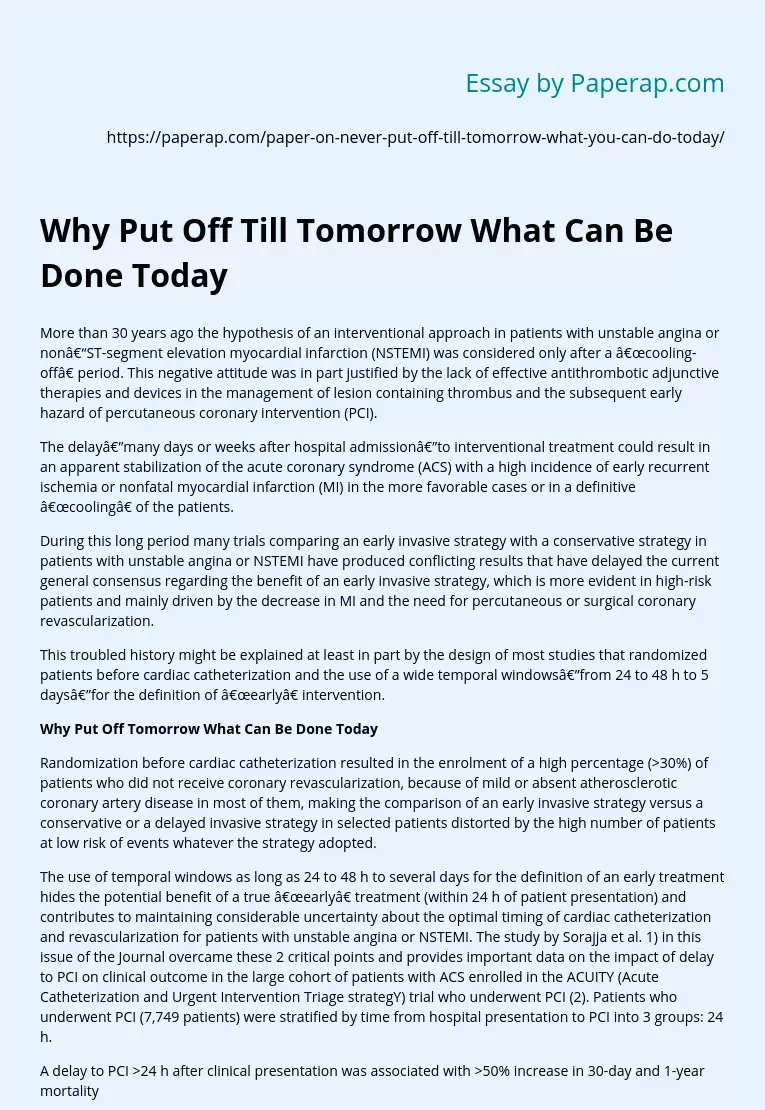Why Put Off Till Tomorrow What Can Be Done Today
More than 30 years ago the hypothesis of an interventional approach in patients with unstable angina or non–ST-segment elevation myocardial infarction (NSTEMI) was considered only after a “cooling-off” period. This negative attitude was in part justified by the lack of effective antithrombotic adjunctive therapies and devices in the management of lesion containing thrombus and the subsequent early hazard of percutaneous coronary intervention (PCI).
The delay—many days or weeks after hospital admission—to interventional treatment could result in an apparent stabilization of the acute coronary syndrome (ACS) with a high incidence of early recurrent ischemia or nonfatal myocardial infarction (MI) in the more favorable cases or in a definitive “cooling” of the patients.
During this long period many trials comparing an early invasive strategy with a conservative strategy in patients with unstable angina or NSTEMI have produced conflicting results that have delayed the current general consensus regarding the benefit of an early invasive strategy, which is more evident in high-risk patients and mainly driven by the decrease in MI and the need for percutaneous or surgical coronary revascularization.
This troubled history might be explained at least in part by the design of most studies that randomized patients before cardiac catheterization and the use of a wide temporal windows—from 24 to 48 h to 5 days—for the definition of “early” intervention.
Randomization before cardiac catheterization resulted in the enrolment of a high percentage (>30%) of patients who did not receive coronary revascularization, because of mild or absent atherosclerotic coronary artery disease in most of them, making the comparison of an early invasive strategy versus a conservative or a delayed invasive strategy in selected patients distorted by the high number of patients at low risk of events whatever the strategy adopted.
The use of temporal windows as long as 24 to 48 h to several days for the definition of an early treatment hides the potential benefit of a true “early” treatment (within 24 h of patient presentation) and contributes to maintaining considerable uncertainty about the optimal timing of cardiac catheterization and revascularization for patients with unstable angina or NSTEMI. The study by Sorajja et al. 1) in this issue of the Journal overcame these 2 critical points and provides important data on the impact of delay to PCI on clinical outcome in the large cohort of patients with ACS enrolled in the ACUITY (Acute Catheterization and Urgent Intervention Triage strategY) trial who underwent PCI (2). Patients who underwent PCI (7,749 patients) were stratified by time from hospital presentation to PCI into 3 groups: 24 h.
A delay to PCI >24 h after clinical presentation was associated with >50% increase in 30-day and 1-year mortality as compared with patients who were treated earlier. Moreover, true “early” PCI was associated with a decreased rate of nonfatal MI. The incremental risk of death attributable to PCI delay >24 h was greatest in high-risk patients. The study results are consistent with those of the ISAR-COOL (Intracoronary Stenting With Antithrombotic Regimen Cooling-Off) trial (3).
This elegant study is the only randomized trial comparing early intervention (delay to PCI 24 h after clinical presentation than among patients who had earlier PCI: no deaths at 1 year in the Thrombolysis In Myocardial Infarction (TIMI) risk score 1 to 2 subgroup with a time-to-PCI 2% in the subgroup with a time-to-PCI >24 h. This point is really important, because it outlines a major limitation of risk-scoring before cardiac catheterization in the individual patient and at the same time weakens a strategy of deferring for expedited cardiac catheterization only patients with a high risk score.
A low TIMI risk score might correspond to a very-high-risk angiographic profile. This event is frequent and confirmed also by early coronary angiography in the PCI-ACUITY patient cohort (1). Nearly one-half of patients who underwent coronary angiography within 24 h of presentation had a baseline target vessel TIMI flow grade 2. A strategy of plaque passivation before PCI could be effective in decreasing PCI complications in the portion of patients who spontaneously or with an intensive antithrombotic treatment may experience improved coronary flow.
Also in this subset of patients with an initial favorable course, the incidence of recurrent refractory ischemia is high—as is MI even after successful emergency PCI—whereas a remarkable portion of patients will not respond to antithrombotic therapy: in the ACUITY PCI study, 38% of patients who underwent coronary angiography with a delay >24 h still had a baseline target vessel TIMI flow grade 36 h after randomization). The difference between groups in the primary study end point (6-month death, MI, stroke) rate was not significant (9. % of patients in the early-intervention group, and 11. 3% in the delayed intervention group) (hazard ratio [HR]: 0. 85; 95% confidence interval [CI]: 0. 68 to 1. 06, p = 0. 15). As in previous trials with similar results, the lack of significant difference in outcome between the 2 strategies might be explained by the fact that the study could be underpowered for the primary end point (the study was stopped prematurely because of recruitment challenges), involved mainly low-intermediate-risk patients with a subsequent low rate of PCI.
Why Put Off Till Tomorrow What Can Be Done Today. (2019, Dec 05). Retrieved from https://paperap.com/paper-on-never-put-off-till-tomorrow-what-you-can-do-today/

